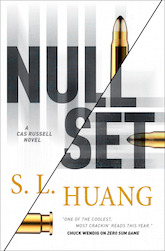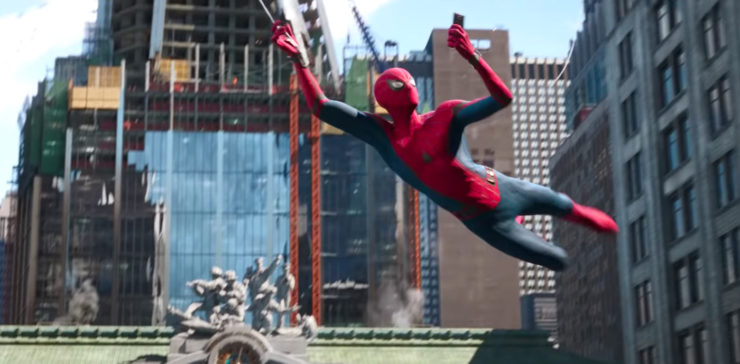Spider-Man has always been inextricably linked with New York City. From his very first appearance in Amazing Fantasy #15, he’s been a city kid, though that he was actually in the Big Apple wasn’t specified until later. (Marvel’s earliest superhero comics tended to take place in generic, unidentified cities, or in “Central City” or the like…)
Some of Spidey’s most iconic moments have been part of the city that never sleeps, most notably Gwen Stacy’s death on the Brooklyn Bridge (or the George Washington Bridge, depending on whether you believe the art or the script, though the story really only makes sense at the former, given the geography).
But while his surroundings have always looked like NYC, his supporting cast has never quite lived up to it—at least until the Marvel Cinematic Universe…
The splash page of Amazing Fantasy #15 introduces Peter Parker, and shows him being shunned by his fellow students at Midtown High School. (We will later find out that Midtown High is in Queens which is, um, not midtown, but then this is New York where Manhattan College is in the Bronx and Madison Square Garden is not in Madison Square.) And every single one of them is white as a piece of paper.
I was born in the Bronx, and have lived 48 of my 50 years in either the Bronx or Manhattan, plus one summer living in Queens. The other two years were spent just over the Hudson River in northeastern New Jersey. As a child growing up in the 1970s and 1980s and attending schools in the city, and as an adult who teaches karate to kids at three different schools in three different neighborhoods in the 2010s, I can assure you that high schools in this city don’t generally look like that. Multiple ethnicities, multiple skin tones, multiple shapes and sizes are all represented, and have been all my life. That life is only seven years younger than Spider-Man’s as a character.
New York has always been an ethnically diverse city, as it’s historically been the primary east-coast port of call for immigrants, particularly in the pre-flight days of the 19th and early 20th centuries.
Buy the Book


Null Set
Ten years ago, I worked for the U.S. Census Bureau as a Crew Leader, enumerating the people of the Bronx, specifically. My crew included people whose ethnic heritage traced back to Angola, China, Cuba, the Dominican Republic, Ecuador, France, Haiti, Ireland, Italy (that would be me), Kenya, Mexico, Poland, Singapore, and Venezuela. Plus two African-Americans who, thanks to slavery, don’t know exactly where in Africa they trace their ancestry to, and a couple from Puerto Rico.
So Spider-Man’s supporting cast in the comics never felt really representative. His fellow high school students were red-haired Flash Thompson, blonde Liz Allan, brunette Sally Avril (who only really cameo’d in Amazing Fantasy #15, but was developed in the 1990s Untold Tales of Spider-Man comic written by Kurt Busiek), plus a bunch of other white kids. When he graduated and went to Empire State University (a stand-in for NYU), most of his fellow students were just as pale: Harry Osborn, Gwen Stacy, Mary Jane Watson, Marcy Kane, Debra Whitman, Roger Hochberg. The non-white characters—Steve Hopkins, Phillip Chang—smacked of tokenism. Likewise the Daily Bugle staff of J. Jonah Jameson, Betty Brant, Ned Leeds, and Ben Urich. The additions of Joe Robertson and Glory Grant helped a bit—particularly Robertson, who has been one of the strongest members of Spidey’s supporting cast—but still. And the complete lack of any Latinx characters despite NYC’s incredibly heavy population of folks from Central and South America is particularly glaring.
The comics themselves are stuck to a degree, as the characters were created between four and five decades ago when white creators defaulted to white characters, and nobody called them on it—or, if they did, did so in a manner the creators felt comfortable ignoring.
I don’t want to ding Stan Lee, Steve Ditko, John Romita Sr., et al too hard for this—it wasn’t just them, after all. It’s The Way It Was, and we can’t go back in time and make Midtown High actually look like a New York high school, or make ESU’s biochemistry graduate program look a bit more representative.
But with new interpretations of the character can also come new interpretations of the supporting cast. We saw this initially in the comics with the “Ultimate” line—which eventually gave us Miles Morales—and again in the early 21st century with three different onscreen versions of Spider-Man.
The first two, however, declined the option. While Spidey’s status as a Noo Yawka was emphasized, particularly in the three Sam Raimi films (notably the we-stand-by-our-city’s-hero scenes on the Roosevelt Island cable car in Spider-Man and the mosh pit in the out-of-control subway in Spider-Man 2), and while the two Marc Webb films made excellent use of several Big Apple locales (notably Times Square and the Brooklyn Bridge), the vast majority of the casting gave us a New York City that was about as ethnically diverse as a KKK rally—a notable exception being Jamie Foxx playing Electro in Amazing Spider-Man 2.
When Spidey was folded into the MCU, Jon Watts gave us a Midtown High student body that actually looks like the student body of a New York high school:
- Ned, played by Jacob Batalon, who’s not just Filipino, but also overweight, a physical type rarely seen in a role where being overweight isn’t a part of the character. He even gets a romance with Betty, and the fact that he’s fat is never mentioned as part of the romance in the least, a refreshing change.
- Betty, played by the Australian Angourie Rice, whom I joked to my wife after seeing Far from Home was the token white girl.
- MJ—originally named Michelle in Homecoming, and going by MJ in Far from Home—is played by Zendaya, who’s half African-American, half Western European.
- Flash, Peter Parker’s nemesis who also adores the hell out of Spider-Man, is played by Tony Revolori, who is Guatemalan.
- Liz, one of Peter’s classmates, who also turns out to be the daughter of the bad guy in Homecoming, is played by Laura Harrier—both actor and character are biracial, as Michael Keaton’s Adrian Toomes is married to Doris Toomes, played by the Haitian Garcelle Beauvais.
All of the above are based (some very loosely) on white characters from the comics: Ned Leeds, a reporter for the Daily Bugle, who later was one of many people who took on the mantle of the Hobgoblin and was killed; Betty Brant, originally J. Jonah Jameson’s secretary at the Daily Bugle and with whom Peter Parker sometimes flirted, who later married Leeds, and who became a Bugle reporter after Leeds’s death (somewhat referenced in Far from Home when Betty is an anchor for the student news program); Mary Jane Watson, one of Peter’s many love interests, to whom he was married for a time until folks at Marvel made the catastrophically idiotic decision to retcon the marriage away (please, do not get me started on that…); Flash Thompson, a football player and the class bully at Midtown High; and Liz Allan, Flash’s girlfriend, and later Harry Osborn’s wife, on whom Peter had an unrequited crush in high school.
Far from Home adds two more characters: Brad, a kid who wasn’t snapped by Thanos and who therefore aged five years and is now contemporary with kids who used to be older than him, and who is played by the half-Malaysian, half-British Remy Hii; and Zach, played by the trans actor Zach Barack, the first trans character in the MCU.
Every time I bring stuff like this up either here or in social media or in person, there’s always someone—invariably someone white—who asks why it matters. That’s an easy question to ask when people who look like you are all over every piece of dramatic fiction. Historically, the vast majority of people portrayed in TV shows and movies and comics are white. Seeing Peter Parker hanging out with all white students at Midtown High in Amazing Fantasy #15 tells any darker-skinned people reading the comic book that they don’t count, that they don’t matter.
Seeing Zendaya and Jacob Batalon and Tony Revolori and Remy Hii and Zach Barack—and, yes, also seeing Tom Holland and Angourie Rice hanging out with them without comment or confusion—refutes that handily. In particular seeing the casual mixed-race couples—the Toomes family, Peter and MJ, Ned and Betty—is extremely heartening.
We all live in this world together, and it’s gratifying to see the most popular movie series in the history of the world take steps to remind us of that, and that it’s a good thing.
Keith R.A. DeCandido is a cis het white guy who is also, frankly, completely done with cis het white guys in his fiction—unless they’re Italian or Jewish, since both are appallingly, criminally underrepresented in fiction except as stereotypes. He is rewatching every single live-action movie based on a superhero comic book every Friday here on Tor.com (based on the current schedule, he’ll get to Spider-Man: Homecoming in October and Far from Home in November), and has also written about Star Trek, Stargate, Batman, Marvel’s Netflix series, and much more for this site since 2011. His latest novels are A Furnace Sealed, an urban fantasy set in the Bronx, Mermaid Precinct, the fifth novel in his fantasy police procedural series, and Alien: Isolation, based on the classic movie series and the hit video game.










